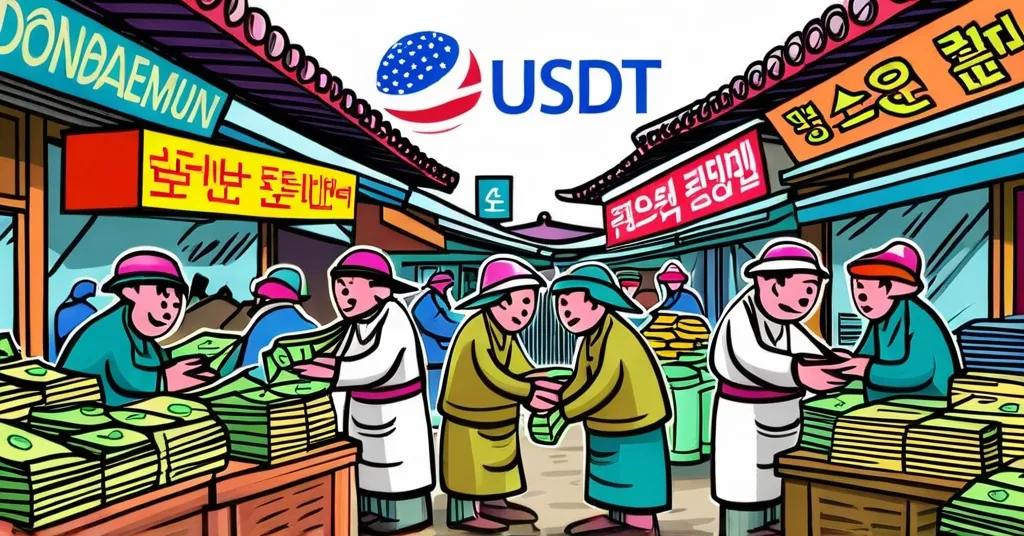Dongdaemun Market Vendors Deny USDT Adoption, Stick to Cash

South Korea’s Dongdaemun Market Vendors Reject USDT Payment Adoption Claims
At Seoul’s bustling Dongdaemun Market, cash is still the king of transactions. Vendors have firmly denied recent reports suggesting widespread adoption of the stablecoin USDT (a type of cryptocurrency known as a stablecoin, which is pegged to the US dollar) for payments, particularly with Chinese buyers. Despite the buzz around cryptocurrency adoption, a deeper investigation reveals that the market’s traders are sticking to their tried-and-true cash method.
- Vendors deny widespread USDT adoption
- Cash remains the preferred payment method
- Smartphone payments among Chinese customers unclear
Lee, a seasoned men’s clothing trader at Dongdaemun Market, dismisses rumors of cryptocurrency adoption with a laugh: “Cash is king here, and it will stay that way.” He explains, “There have been stories about crypto adoption here before. But the reality is, stablecoins are not used much in the market, contrary to the reports. Traders are quite change-averse. And they hate leaving behind evidence of their transactions. That’s why most transactions are carried out in cash here.”
Dongdaemun Market, a sprawling hub for fashion and textiles, attracts throngs of international buyers, with Chinese traders making up a significant portion. Some crypto enthusiasts had boasted that around 10% of the market’s wholesale trade was conducted using USDT. Yet, the vendors’ preference for cash tells a different story. They’re wary of the traceability that comes with cryptocurrencies, preferring to keep their transactions off the record. Lee adds, “Dongdaemun merchants are not likely to use crypto in peer-to-peer transactions because they tend to use agents to process payments on their behalf. I don’t know what will happen in the future. But I think that most won’t use stablecoins for the time being because of tax-related issues.”
The age of the merchants also plays a role in their reluctance. Park, another vendor, noted, “Most fashion traders were born in the 1950s and 1960s, so I think it is difficult for them to use cryptocurrency.” This generational gap adds another layer of complexity to the adoption of digital currencies in traditional markets. The impact of age on cryptocurrency adoption is a significant factor to consider.
While the vendors at Dongdaemun Market are sticking to their cash, there are whispers of smartphone payments among Chinese customers. Myung-hee, a part-time employee at a local shopping mall, observed, “The stall I work at does not accept USDT or any other token. However, I do see a lot of Chinese customers paying using their smartphones around the area, with local vendors accepting the payments on their own handsets. I have no idea if these are crypto transactions or not – I really couldn’t say.” This anecdotal evidence suggests that while there might be some use of digital payments, it’s not clear whether cryptocurrencies are involved. Common payment methods like WeChat Pay and Alipay, popular in China, could be the preferred choice over cryptocurrencies.
The situation at Dongdaemun Market underscores the broader challenges of integrating cryptocurrencies into traditional markets. Despite the popularity of USDT in China and other BRICS nations, where it’s been dubbed the “de facto fiat in Chinese trading,” the transition to everyday use in markets like Dongdaemun is still in its early stages. A tech journalist in Weekly Dong-a noted, “While cryptocurrencies were mainly used for illegal transactions in the past, they have recently been actively used in the import and export of general goods such as clothing, textiles, and electronics.” The usage of Tether USDT in China and BRICS nations highlights its growing role in global trade.
The slow pace of cryptocurrency adoption at Dongdaemun Market reflects broader trends in the crypto world. South Korea, known for its vibrant crypto market, has postponed cryptocurrency taxation until 2027 due to political and economic sensitivities. This regulatory uncertainty, coupled with the preference for untraceable cash transactions, poses significant hurdles for the adoption of cryptocurrencies. However, as smartphone payments become more prevalent and global economic landscapes evolve, the potential for future adoption remains. Discussions on USDT adoption in South Korea reflect the community’s interest in the subject.
While the dream of a crypto-dominated world is tantalizing, the reality at Dongdaemun Market shows that we’re not there yet. Crypto enthusiasts can keep dreaming about a cashless future, but at Dongdaemun Market, cash is still the undisputed champ. Yet, the potential for change exists, and as technology and regulations evolve, we might see a shift in the future. The ongoing debate about cash vs cryptocurrency in traditional markets continues to shape the landscape.
Key Takeaways and Questions
- What is the current state of USDT adoption at Dongdaemun Market in South Korea?
Vendors at Dongdaemun Market have denied widespread adoption of USDT for payments, with cash remaining the preferred method. Despite some claims of its use, particularly for transactions with Chinese buyers, the market’s traders have expressed a preference for cash due to its untraceability and their aversion to change.
- Why do vendors at Dongdaemun Market prefer cash over cryptocurrencies?
Vendors prefer cash because cryptocurrency transactions are traceable, which they want to avoid for tax reasons. Additionally, many traders are change-averse and rely on agents for payment processing, further complicating the adoption of cryptocurrencies.
- What role do Chinese buyers play in the potential adoption of USDT at Dongdaemun Market?
Chinese buyers are significant to the market, with some reports suggesting they drive the use of USDT for wholesale purchases. However, the extent of this adoption is unclear, as many vendors deny using USDT, and smartphone payments among Chinese customers may not necessarily involve cryptocurrencies.
- How does the age of Dongdaemun Market vendors impact cryptocurrency adoption?
The age of the vendors, many of whom were born in the 1950s and 1960s, is a significant factor in their reluctance to adopt cryptocurrencies. Older merchants find it challenging to adapt to new technologies like cryptocurrency.
- What is the broader significance of USDT in global trade, particularly in China?
USDT is highly popular in China and other BRICS nations, often used as a ‘de facto fiat’ in trading despite regulatory crackdowns. Its use in international trade has increased, particularly for the import and export of goods like clothing and electronics.



